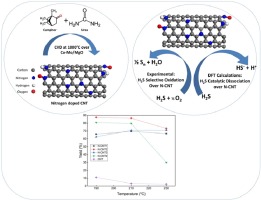Journal of the Taiwan Institute of Chemical Engineers ( IF 5.5 ) Pub Date : 2018-01-12 , DOI: 10.1016/j.jtice.2017.12.026 Ebrahim Ghasemy , Hosein Banna Motejadded , Alimorad rashidi , Tayebeh Hamzehlouyan , Zohreh Yousefian

|
In the present work, mesoporous nitrogen-doped carbon nanotubes (N-CNTs) were synthesized by using a low-cost and unique set of precursors (camphor and urea). The CVD method at 1000°C was used with different camphor/urea ratios, and Co-Mo/MgO nanocatalyst was utilized as growth catalyst. Application of mesoporous N-CNTs in selective oxidation of H2S was studied experimentally and N-CNTs interactions with H2S was also investigated using DFT calculations. The as-synthesized N-CNTs were characterized using FTIR, FE-SEM, elemental analysis, X-ray diffraction (XRD), XPS and nitrogen adsorption/desorption. The N-CNT2 sample with urea to camphor ratio (U/C) of 1 showed the highest sulfur yield at the three temperatures studied for which selectivity and conversion of 89% and 97% were obtained at 190°C. Considering experimental results, the relatively higher amount of pyridinic nitrogen (i.e. pyridinic and pyridinic oxide) was suggested as the reason for such high catalytic activity which was proved by quantum mechanical calculations. Further, DFT calculations were performed for elucidating the reaction and finding the most active nitrogen atoms in which the pyridinic oxide was found to be the most active followed by pyridinic. According to experiment and DFT results, the pyridinic species were determined as the most active phases of N-CNT toward H2S oxidation.
中文翻译:

由樟脑和尿素制备的N掺杂的CNT纳米催化剂用于气相脱硫:实验和DFT研究
在目前的工作中,通过使用低成本且独特的前驱体(樟脑和尿素)合成了中孔氮掺杂碳纳米管(N-CNT)。CVD方法1000在不同的樟脑/尿素比例下使用°C,并使用Co-Mo / MgO纳米催化剂作为生长催化剂。实验研究了介孔N-CNT在H 2 S选择性氧化中的应用,并使用DFT计算研究了N-CNT与H 2 S的相互作用。使用FTIR,FE-SEM,元素分析,X射线衍射(XRD),XPS和氮吸附/解吸对合成后的N-CNT进行表征。尿素与樟脑比率(U / C)为1的N-CNT2样品在所研究的三个温度下均显示出最高的硫收率,在190°C下的选择性和转化率分别为89%和97%℃。考虑到实验结果,提出了相对较高量的吡啶氮(即吡啶和氧化吡啶)作为如此高的催化活性的原因,这通过量子力学计算得到了证明。进一步地,进行DFT计算以阐明反应并发现最活跃的氮原子,其中吡啶鎓氧化物被发现是最活跃的,其次是吡啶鎓。根据实验和DFT结果,将吡啶类物质确定为N-CNT对H 2 S氧化最活跃的相。









































 京公网安备 11010802027423号
京公网安备 11010802027423号